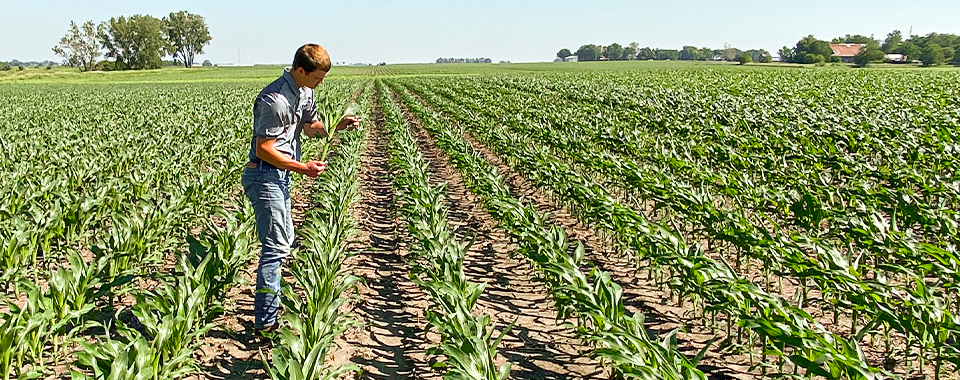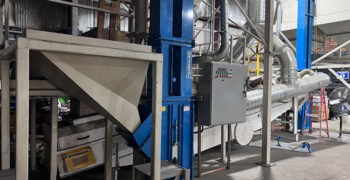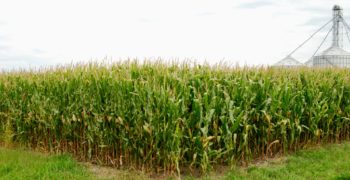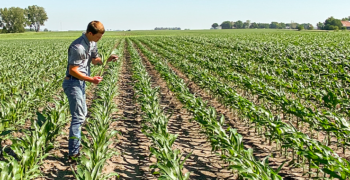From the first seed planted, to the last kernel out of the combine, crop scouting is key to a successful harvest. Each season is different from the last — new pests, disease and weather patterns bring new challenges every year. Without crop scouting, it is impossible to know what pests could be causing you the greatest risks for reduced yields.
Monitoring fields throughout the growing season can trigger informative decision making and prevent future issues entirely. While there may not be an available treatment in some cases, any insights gained from crop scouting can help us better understand what happened in the field and adjust management practices in the future.
Keep corn standing tall
“Evaluating a crop’s stand is a major starting point early in the growing season,” says Joel Zeman, North Central Iowa Champion Seed District Sales Manager. “We are not just evaluating how the crop emerged, but we are evaluating ourselves and the equipment’s performance.”
Zeman still remembers a time when he and Champion Seed dealer, Lucas Bravard, got a call about corn that had a poor stand. After they got to the field and started digging, they noticed seed at variable depths. After using Climate FieldviewTM they were able to determine the spot in the field that had issues — in that area some seeds were 2 inches deep while others were on top of the soil. High planted speeds along with incorrect down pressure and depth settings caused the poor stands and emergence. From this experience, Zeman always reminds growers to take time to evaluate planter performance and adjust as you go.
“Not every acre is the same, so make adjustments when needed. Some farmers only get 20-30 planting seasons to put in a crop, so let’s make sure we do it right,” Zeman says.
Every day is different
Stephan McClure, Central Nebraska Champion Seed District Sales Manager, says he always champions frequent crop scouting because conditions can change on a whim.
“Agriculture is always changing. It’s important to be flexible and willing to adapt to the changing conditions throughout the growing season and make the best-informed decisions when they need to be made,” McClure says.
McClure has multiple examples of this happening to him but one instance really sticks with him. In his area of Nebraska, they can often battle foliar diseases. Knowing his customers’ previous field history helps him identify favorable weather patterns for disease pressure. When the right environment for a disease came to his region, he was able to find infected fields and watch the progression of the disease. From there, he was able to make a fungicide recommendation to help slow the spread and prevent major yield loss.
“Even after the fungicide has been applied, you cannot walk away from the field for long. You have to continue to scout and stay on top of the disease,” McClure says.
McClure says he often sees a broad spectrum of variables to monitor during the growing season. Insects, disease, water usage and fertility, just to name a few. With so many factors to monitor, it is important to be in the field weekly to adapt to the changing environment.
Stay vigilant with crop scouting
 Without spending time in the fields, McClure says growers would have no idea what could be going on out there. He urges everyone to get boots on the ground and eyes in the field to investigate and evaluate. David Williamson, Northwest Iowa/Southeast South Dakota Champion Seed District Sales Manager, agrees.
Without spending time in the fields, McClure says growers would have no idea what could be going on out there. He urges everyone to get boots on the ground and eyes in the field to investigate and evaluate. David Williamson, Northwest Iowa/Southeast South Dakota Champion Seed District Sales Manager, agrees.
“When we find issues in the field, we need to acknowledge them and make decisions going forward that are not only going to help the crop for this year but those fields for years to come and help the overall crop management practices,” Williamson says. “Monitoring the crops progress alongside our customers is so important. With so many pests and weather events to take down a crop, being in the fields all the time can prevent or limit the damage.”
Williamson recalled an instance when he called on his customer to go crop scouting midway through the growing season. The farmer had been busy with livestock and had not looked at the field in quite some time. When Williamson went to scout his fields shortly after silking and found that the field had been inundated with Corn Rootworm Beetles. Due to the large quantity of bugs in the field they had potential to really decimate the number of viable ears left to pollinate and substantially reduce yield.
Williamson and his customer worked together to have aerial applicators spray for the Corn Rootworm Beetles and managed to salvage the remainder of the pollination window. He counts this as a perfect example of the importance of being vigilant and in the fields during key growth stages. It can be the difference between a disaster and a successful yielding field.
Don’t forget to check roots
Williamson also recommends performing root digs throughout the year to monitor crop health and performance.
“The roots are really where it all begins. Without a robust and healthy root system, the crop really does not have a chance to reach top end yield levels,” Williamson says.
During the year Williamson likes to go with his customers into fields and dig up roots to look for long healthy roots with a lot of root hairs. Nutrients for the crop make their way into the plant via the root system this is where yield, standability and stress tolerance all start.
Crop scouting for the win
A crop’s greatest yield potential is determined before it even leaves the bag. As soon as those seeds are placed into the soil, all other factors work against them to reduce the hybrids potential to reach maximum yield. Pests and disease can already be present within a field, and without knowing what is in your soil from the start can cost you down the road. It is important to go crop scouting throughout the entire growing season, not only for the current year, but for years to come.



